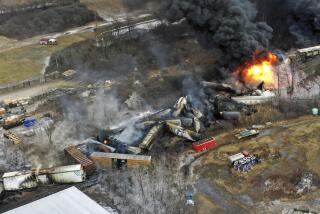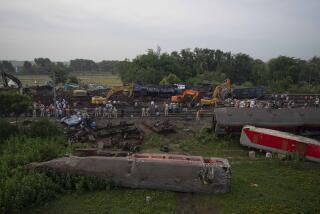Deadly Chinese bullet train crash spawns anger, safety concerns
- Share via
Reporting from Beijing — A toddler was discovered alive Sunday afternoon after two bullet trains collided in eastern China a day earlier in a deadly incident that has intensified concerns about the country’s vaunted high-speed rail system.
The official New China News Agency said a boy was found unconscious by firefighters inside the wreckage and taken to a hospital.
The rescue came shortly after three senior railway officials were fired in response to the collision, which killed at least 43 people and injured more than 200 in Wenzhou, a city in Zhejiang province.
The accident took place Saturday night when a train from Hangzhou stalled after being hit by lightning and was then rear-ended by a train originating from Beijing. The violent crash sent four carriages from the oncoming train tumbling 66 feet off an elevated track.
Rescuers found hundreds of terrified passengers trapped under debris.
“Please save us,” a passenger wrote on a Twitter-like blog. “The train is leaning toward one side now. And it’s totally locked. The first few carriages hit each other.”
Chinese President Hu Jintao and Premier Wen Jiabao called for an “all-out effort” to rescue passengers and dispatched Vice Premier Zhang Dejiang to the scene of the accident, state media reported.
Still, anger remained high Sunday among Chinese Internet users who posted millions of comments online mourning victims — while also questioning the safety of the national high-speed rail system and calling for a thorough investigation.
“The railway minister should be required to resign his post immediately; don’t go blaming lightning for this incident, the one who should be blamed most is you!” read a comment translated into English by the website ChinaGeeks.
Many were outraged over video that was posted online Sunday showing backhoes breaking apart carriages that had fallen off the elevated tracks. Another photograph online showed what some thought were the same backhoes burying parts of the train.
Internet users suspecting a cover-up questioned how evidence could be destroyed so quickly and wondered whether the carriages had been properly inspected by rescue teams for passengers first.
Authorities have so far been unable to explain why the oncoming train did not stop in time and whether engineers anticipated vulnerabilities to lightning strikes.
The disaster will no doubt invite greater scrutiny of the already beleaguered Ministry of Railways.
The three officials who were fired Sunday included the head of the Shanghai rail bureau and the bureau’s Communist Party chief, whose jurisdiction included one of the trains.
The ministry was rocked by scandal in February when its chief, Liu Zhijun, was dismissed after allegedly taking $125 million in kickbacks tied to shoddy construction work.
Two months later, the ministry reduced maximum speeds along the network to reduce costs and as a safety precaution.
China’s high-speed rail system, the largest in the world, has attracted controversy for years because its engineering is alleged to have been copied from European and Japanese technology and because the national track network was laid in record time.
Officials have touted the country’s rail technology as the world’s most advanced and have eyed foreign markets including California.
But the marketing campaign, so far, has not gone well. The recently opened Beijing-Shanghai line, which features newer and faster trains than those that collided in Wenzhou, has been beset by power failures and delays in recent weeks. The $32.5-billion line was meant to be a symbol of China’s engineering prowess.
The accident Saturday has struck the public as something of a national embarrassment. Chinese blogs have been noting that Japan hasn’t had a bullet train-related fatality since its service opened in 1964. High-speed rail was introduced to China in 2007.
Tommy Yang in The Times’ Beijing bureau contributed to this report.
More to Read
Sign up for Essential California
The most important California stories and recommendations in your inbox every morning.
You may occasionally receive promotional content from the Los Angeles Times.











